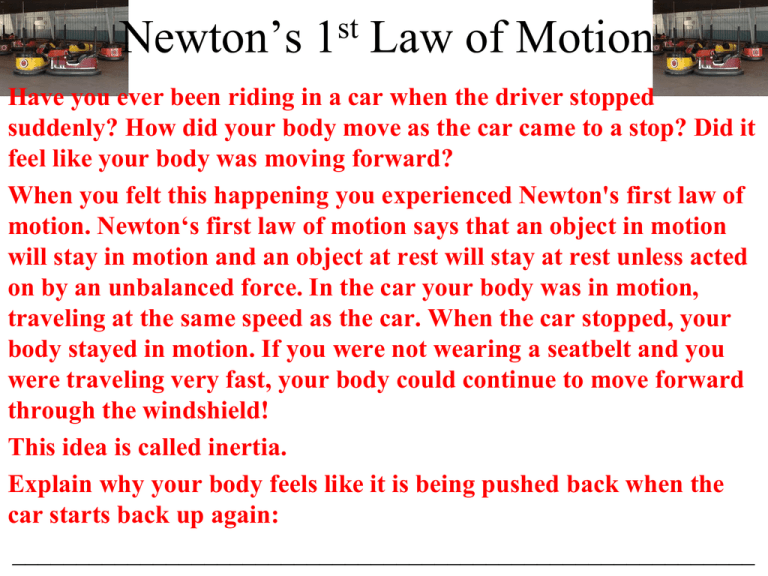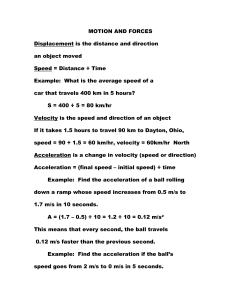Did it feel like your body was moving forward?
advertisement

Newton’s st 1 Law of Motion Have you ever been riding in a car when the driver stopped suddenly? How did your body move as the car came to a stop? Did it feel like your body was moving forward? When you felt this happening you experienced Newton's first law of motion. Newton‘s first law of motion says that an object in motion will stay in motion and an object at rest will stay at rest unless acted on by an unbalanced force. In the car your body was in motion, traveling at the same speed as the car. When the car stopped, your body stayed in motion. If you were not wearing a seatbelt and you were traveling very fast, your body could continue to move forward through the windshield! This idea is called inertia. Explain why your body feels like it is being pushed back when the car starts back up again: __________________________________________________________ Newton’s 2nd Law of Motion If a ping pong ball and a basketball were both dropped at the same time from the roof of our school, which would hit the ground with a greater force? Common sense tells us that the basketball ball would. The difference in forces would be caused by the different masses of the balls. Newton stated this relationship in his second law, the force of an object is equal to its mass times its acceleration. List two other situations where Newton's 2nd Law may apply. Forces A. Newton’s 2nd Law 1. A net force acting on an object causes the object to accelerate in the direction of the net force. 2. a = FNET / mass or a = F / m Using F = m × a 1.Your bicycle has a mass of 9.1 kilograms. You accelerate at a rate of 1.79 m/s2. Calculate the net force that is accelerating the bicycle. 2.The Space Shuttle has a liftoff mass of 2,041,000 kg and accelerates at a rate of 16 m/s2. Calculate the force (thrust) that is accelerating the Space Shuttle. 3. A rocket accelerates at 56 m/s2. It has a mass of 800,000 kg. Calculate the force (thrust) that the rocket engines must supply. Using a = F ÷ m 1.A runner has a mass of 89 kilograms. He produces a force of 84 Newtons between the ground and his running shoes. How fast does he accelerate? 2.Calculate the acceleration of a car if the force on the car is 450 Newtons and the mass is 1300 kilograms. 3. Calculate the acceleration of a jet car racing on the Bonneville Salt Flats if the force on it (the “Thrust”) is 500,000 Newtons and the mass is 2,100 kilograms. Newton’s 3rd Law of Motion Imagine a rocket is being launched from the earth. Hot gases are pushed out from the bottom of the rocket as the rocket is pushed upward. The force of the gases pushing against the surface of the earth is equal and opposite to the force with which the rocket moves upward. The motion of the rocket can be explained by Newton's third law, for every action there is an equal and opposite reaction. In other words, when one object exerts a force on another object, the second object exerts a force of equal strength in the opposite direction on the first object. Practice Problems 1. Sam pushes on the wall with a force of 25 Newton (N) to relieve some stress. What force is being exerted back by the wall if the wall does not move? 2. Sara pushes against Adan with a force of 9 N, but he doesn’t move. What force is Adan pushing back with? Momentum • Product of an object’s mass and its velocity. • An object has a large momentum if the product of its mass and velocity is large. • Momentum for any object at rest is 0. • You can calculate momentum by multiplying an object’s mass (in kilograms) and its velocity (in meters per second). Momentum=Mass x Velocity Practice Problems • Which has more momentum, a 0.046kg golf ball with a speed of 60.0m/s, or a 7.0kg bowling ball with a speed of 6.0m/s? • What is the momentum of an 80kg runner moving at the speed of 2.5m/s? B. Friction 1. Force that opposes motion between two surfaces in contact. 2. Amount depends on: a. Kinds of surfaces in contact. b. Amount of force pressing surfaces together. Something that weighs more will have greater friction. 3. Friction is caused by microwelds 4. Types of friction: a. Static (usually the greatest) b. Sliding c. Rolling (usually the least) C. Air resistance (drag force) 1. Force that opposes motion of objects through air 2. Pushes up on falling objects 3. Affected by object’s speed, size, shape 4. Without drag force, all objects fall at the same rate 5. Terminal velocity is the max speed at which an object can fall D. Gravity 1. Attraction between objects 2. Weakest force in universe 3. Farthest range 4. Directly proportional to the masses of the objects 5. Inversely proportional to the squares of the distance between E. Gravitational Acceleration 1. g = 9.8 m/s/s on Earth 2. FWEIGHT = m x g 3. All objects fall with the same g 4. Weight is NOT the same as mass Practice Problems 1. Sara has a mass of 11.22g. How much does she weigh? 2. A ball has a weight of 10 pounds. What is the mass of the ball? 3. A chair has a weight of 7 lbs. What is the mass of the chair? F. Free Fall (Weightlessness) 1. As long as an object is free falling, nothing exerts an upward force 2. With no upward force, FW = 0 N G. Projectile and Circular Motion 1. Projectile motion a. Follow a curved path b. Two types of motion are independent of one another: 1) Horizontal (based on initial velocity and inertia) 2) Vertical (based on gravity) c. An object launched horizontally will land at the same time as an object simply dropped from the same height 2. Circular Motion a. Objects moving in circular paths accelerate toward the center b. Centripetal acceleration c. Centripetal force (FC = m x aC) d. Centrifugal force is imaginary e. Weightlessness in orbit exists because objects are constantly falling toward Earth, but have enough forward velocity to keep them in orbit






